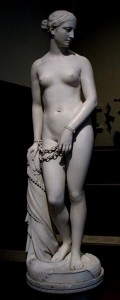Ali Altaf Mian is a friend and a fellow blogger. Dwellings of Thought is the place where he shares insightful and delightful reflections on everything from Lady Gaga to Hegel. He is also a graduate student of Religion at Duke University. Last week I made a post, Geishas and Graffiti, showcasing graffiti pieces by a UK-based street artist named HUSH. Ali noticed the historical narrative embedded in the artwork and left a comment, initiating a conversation that we then continued on Facebook. Ali’s deep thoughts on the artwork was not something I could keep to myself, so at some point in the conversation, I had to stop and ask him to write a short response that I could post on Brittle Paper, which he kindly did. Enjoy Ali’s wise reading of HUSH’s fascinating graffiti as a historical account of the feminine.

The work of art titled “Dis-grace-D I” by HUSH invokes both history and subjectivity. The four figures depicted here trace a genealogy of representation of the feminine. The manga figure, which is the centerpiece of the work, looks away from all three. While the three in the background, so to speak, do not have a singular gaze either. The perspectival look of each is different. Moreover, all four differ in their positions, highlighting “position” as one of the 9 Aristotelian accidents that individuates units within the same form. The one to the left of the manga figure is modeled on “The Greek Slave” by Hiram Powers (1851), which might be based on the “Venus de’ Medici” in the Uffizi Gallery in Florence, Italy.

I see the Greek slave and the manga figure creating a dialectic of female bondage and freedom, with the two other ones looking down upon, and participating in, this dialectic in their own ways. The one directly atop, yet slightly to the right, of “The Greek Slave” is most likely evocative of modernity, while the one juxtaposed next to it, in the upper right hand corner, is suggestive of early modern, or even late medieval, representations of the feminine countenance. I say that the “The Greek Slave” and the manga figure create the two poles of the dialectic because if you look at the respective directions of their faces, the Greek figure’s face is most turned away from us, while the manga figure’s face is most readily available to us. The other two create fields of vision that intersect with the dialectic of subjectivity being orchestrated here. In its own way, this work invites us to see where our vision intersects with this historical genealogy of the feminine. It makes sense, then, to title the piece, “Dis-grace-D I,” which invokes all of the following possibilities for those affected by this piece through engaging it:
1) feeling disgrace
2) feeling grace
3) Being disgraced
4) Being graced








Boye January 30, 2012 15:27
Thanks for revealing what I only previously looked at.